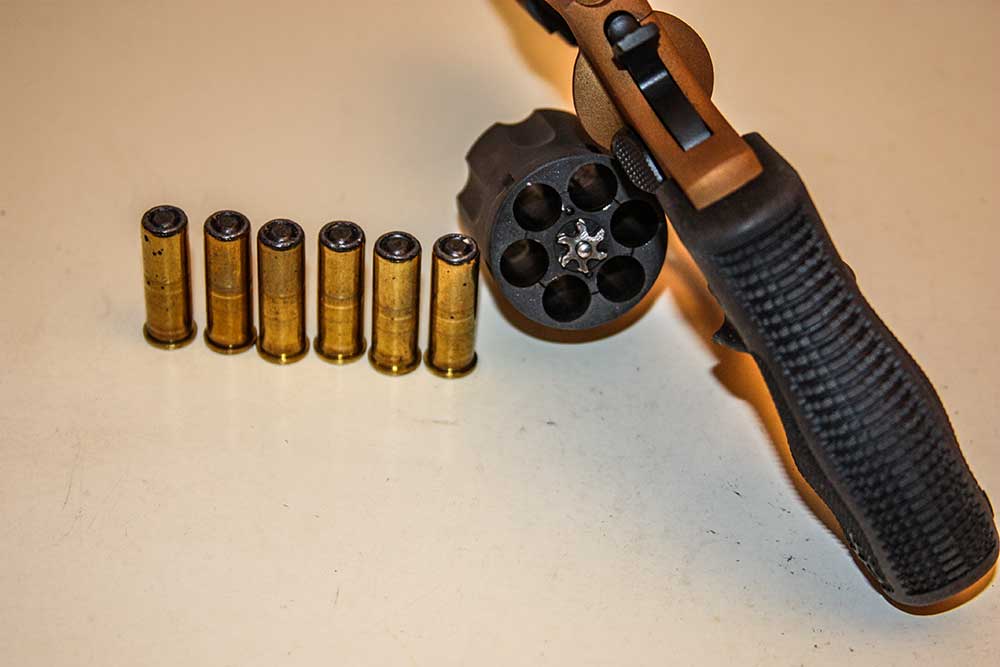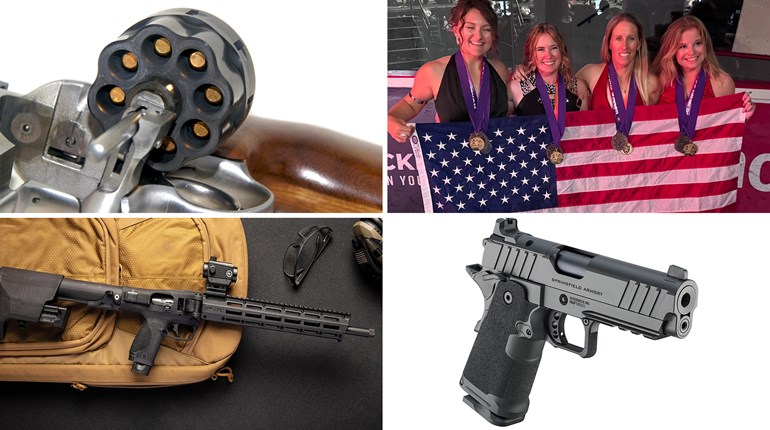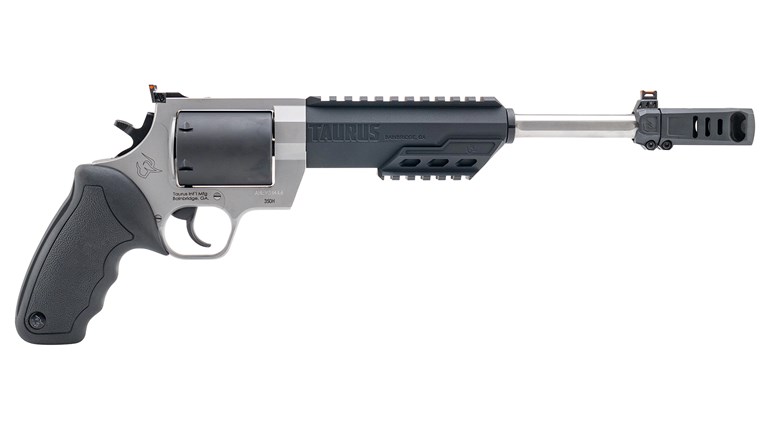
Except for the two-tone tan/matte-black finish, at first glance, Taurus’s Model 856UL 38 Spl. revolver appears to be a conventional, small-frame, “snub-nose” revolver. It has a fixed front-sight blade and a notch in the frame for a rear sight. It has an external hammer, indicating it may be fired single- or double-action. It has what Taurus calls soft rubber grips, though they are considerably harder than some of the “thin ribbed” rubber grips Taurus has offered on past guns.
Fit and finish are good, particularly where the side plate joined the frame. It’s when you open the cylinder that you see the big difference between this pocket revolver and others of the same size; the Taurus holds 6 rounds of ammo rather than 5, yet the gun’s total weight has been held to 15.7 ounces. Off to the range!

Some preliminary dry firing revealed a rough, heavy double-action trigger pull and a relatively heavy single-action trigger pull. Admittedly as a longtime revolver guy, I’m a bit of a trigger snob, which means that sometimes I forget the gun’s mission and dwell upon my personal preferences. More on the trigger shortly. The revolver has a transfer bar safety which prompted me to ignore Taurus’ suggestion in their manual that the gun be carried with an empty round under the hammer.
The ejector rod is nicely protected by an integral barrel shroud but like other pocket revolvers, when the rod is at full stroke, 38 Spl. cases are still partially contained in the cylinder chambers. Learn the proper reloading procedure, i.e. muzzle up, so that gravity is working for you and a vigorous push downward on ejector rod to ensure all empty cases fall clear of the cylinder chambers. The rubber grips are slightly abrasive, meaning that after about 150 rounds, my shooting hand knew where the rough spots were, but I had no blisters or abrasions.

I’m relatively ambivalent about 2-tone guns, but at first, I really didn’t see a useful purpose for the black/tan color scheme on the Taurus Model 856. I changed my mind during the two range trips. In reasonably good ambient light conditions, the black, serrated front sight blade contrasts nicely with the rear notch in the anodized tan frame making for a pretty good sight picture with no wash out or glare. That’s always a useful thing when using a handgun.
Due to inclement weather and a muddy outdoor range, my first range trip was indoors. The range I used has the capability to vary brightness and “dial in” computer-controlled range settings. I sent a white target 15 yards down range and proceeded to shoot groups from the off-hand position, firing single action. Table below shows group sizes.
Moving the targets to 10 yards, dimming the lights slightly and firing double action basically doubled the group sizes. This exercise involved loading six rounds of each brand of ammo and shooting off hand at a rate of about 1 round per second. That’s about as fast as most indoor ranges will allow you to shoot. One of the 24 shots grazed the arm of the silhouette target, while all others stayed in the chest cavity.
I had two minor concerns with the small Taurus, both concerning possible problems in presenting the gun from concealment. Conventional wisdom says that an internal hammer (or one that’s been bobbed) is best for a pocket revolver, and the Taurus Model 856 has an external hammer spur. Using TUFF Products size 10 pocket holster, I practiced my draw stroke at home using various trousers.

My blue jeans presented some problems, but it was due to having small pockets and pocket openings. Gripping the pistol requires making a fist while your hand is in the pocket. It was my fist that made the draw stroke difficult, not the hammer. Resting my thumb on the hammer during the draw stroke prevented it from snagging. Tactical trousers with larger pockets and openings posed no problem.
I also thought the rubber grips might snag a covering shirt or jacket when sweeping it aside to gain access to the gun. In pocket-carry mode, my hand shielded most of the grip’s surface from contact with the pocket’s lining as I pulled the gun from the holster and out of the pocket. When carried in a strong-side OWB holster, my preferred method of concealed carry, the cover garment is in contact with the grips most of the time. A couple of my blue denim-cotton shirts did have a tendency to “grab” the grips, which is why I would go with the pocket carry. As always, wardrobe and life style have a lot to say about your preferred concealed-carry technique and hardware.
After the outdoor range dried out a bit, I took the Taurus Model 856 and a chronograph to get velocity readings. I also recruited a friend who is an active-duty law-enforcement officer and department firearms trainer. He still enjoys 20/20 vision, and while he admitted that the black-on-tan sight picture would suffer some degradation as ambient light waned, he liked the Taurus’ rugged and relatively large sights.

On duty, he always carries a small-frame revolver in addition to his duty gun, but he carries it as a reserve gun for emergency-use only. In that context he made two comments about the Taurus’ trigger. First, the pocket revolver’s mission is strictly close range, like when the devil is at your throat and seeing tomorrow depends on your second gun. A butter-smooth double action trigger is not required in that scenario.
Second, the 856UL’s trigger seemed to get smoother and lighter the more we used it. It was definitely an example of natural break-in, because I had not touched the innards or even cleaned the gun since receiving it. His assessment of the Taurus can be summed up in two words: mission ready! Suggested retail pricing on the Taurus Model 856 starts at $363.63.




































